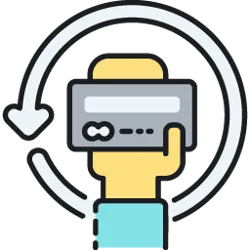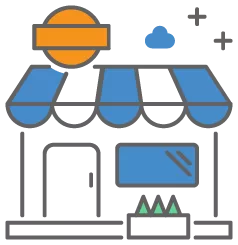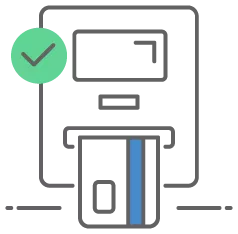
If you’re a merchant utilizing business banking services at Wells Fargo, it’s imperative you understand how to dispute a chargeback with Wells Fargo—because they will occur.
Chargebacks can be one of the most detrimental challenges for your business. Even if your product or service was properly delivered, some customers may still request the money back, leaving you with product loss, revenue loss, and a chargeback fee. In this article, we explain how you can go about filing a chargeback dispute at Wells Fargo, the benefits of disputing chargebacks, and tips on how to avoid chargebacks altogether. Let’s get started!
How Do Wells Fargo Chargebacks Work?
The Wells Fargo chargeback process generally works the same as any other bank. Once a customer disputes a charge, the merchant is notified of the chargeback. From there, they can choose to fight it or accept it. If they accept it, they agree to reimburse their customer – and if they fight it, the issuing bank reviews the evidence and comes to a decision. If the chargeback stands, the merchant can appeal it through arbitration, but they risk paying up to $500 in fees.
What are Wells Fargo Chargeback Fees?
If you hold a merchant account at Wells Fargo, chargeback fees can add up. Each time a chargeback comes through you will be charged $25. If you choose to dispute a chargeback and it goes past the representment stage, the losing party will also have to pay up to $500 in arbitration fees. With this being said, it’s best to be sure that the chargeback isn’t your fault before filing a dispute.
Benefits of Disputing Wells Fargo Chargebacks
While chargebacks can negatively impact your business, they also provide an opportunity to learn more about the complaints your customers have regarding specific elements of your operations. After which, you can adjust your operations accordingly to better meet your customer’s expectations and prevent future chargebacks. So, yes—while chargebacks can drain your resources, there’s also a silver lining.
Time Limit to Dispute a Transaction at Wells Fargo
Simply ignoring customer chargebacks can result in paying chargeback fees and raising your business’s chargeback ratio. Each time a chargeback occurs, you’re subject to a chargeback fee, so it’s best to evaluate each one in order to determine if you should dispute it.
Upon receiving notice of the chargeback, you, as the merchant, have a certain number of days to respond based on your customer’s card brand. For Visa and Discover, you have 30 days, for Mastercard, you have 45 days, and for American Express you have 20 days. If you want to dispute the chargeback, the claim goes into the representment process, during which its validity is evaluated and a ruling is made. If you’re unsatisfied with the representment decision, you have more time to take the chargeback to arbitration. For Visa and Discover, you have 10 days; for Mastercard, you have 45 days; and for Amex, there is no arbitration process.
Note: For a more in-depth explanation of this process, check out our comprehensive guide about how to dispute chargebacks.
Steps for Businesses to Handle Wells Fargo Chargebacks
When filing a chargeback dispute with Wells Fargo, documentation verifying the legitimacy of the transaction will be requested. Below explains how to execute retail, eCommerce, MOTO, and various other transactions in a manner supplying you with the necessary documents to file and potentially win a Wells Fargo chargeback dispute.

Chargeback disputes for retail businesses
Ensure you comply with the annual transaction requirements by Visa, Mastercard, Discover, and American Express, then follow these guidelines during a transaction:
- Request your customer dip their EMV chipped card and swipe their magnetic stripe cards through your terminal, as this creates proof the card was present. If the terminal displays a declined message, request a new form of payment from the customer.
- If a card must be manually entered into a virtual terminal, obtain an imprint or validate the card verification value (CVV). The imprinted copy must include all transaction information, including the transaction amount, the business name and location, and the cardholder’s signature.
- Finally, the authorization amount should be for the entire sale amount. Don’t break the sale into several smaller sales.

Chargeback disputes for Internet & MOTO businesses
For card-not-present (CNP) transactions, including mail orders, telephone orders, and eCommerce sales, follow the below guidelines:
- Implement an address verification system (AVS) to confirm your customer’s billing address.
- Always validate the CVV for internet and phone orders.
- Provide Wells Fargo with a local or toll-free phone number they can include in your billing statement. Additionally, by supplying a phone number for your customers, you help prevent chargebacks from happening. Before disputing a charge, your customer can contact you directly with questions, at which point you can rectify the situation by offering a refund.
- Ensure that your shipping partner can provide proof of delivery in case of a dispute. If the merchandise is very expensive, request the buyer sign for the delivery.
- Implementing online fraud protection tools will further improve the security of CNP transactions, reducing chargebacks and fraudulent activity. Some excellent fraud protection measures include 3D Secure, Mastercard SecureCode, Verified by Visa, Discover ProtectBuy, and American Express SafeKey.

Chargeback disputes for other types of businesses
For all other types of business, the following practices will set you up for success with disputing a Wells Fargo chargeback:
- Your business name will appear on the cardholder’s statement, so ensure you provide Wells Fargo with the business name your customers are familiar with. If you don’t think they will recognize your name, consider telling your customers what name to expect. Keep in mind that many chargebacks are initiated because customers don’t recognize the business’s name on their billing statement, even when the charge is valid.
- Respond to retrieval requests and dispute notifications as soon as possible.
- Authorized employees can access sales drafts (including those for recurring payments) for 180 days after the initial transaction date. Make sure to store these in a safe and secure environment.
- Finally, always receive customer authorization for a transaction.
How to Use the Wells Fargo Dispute Manager for Chargeback Management
Wells Fargo’s Dispute Manager is an online service that provides businesses with software to manage chargeback and retrieval requests. After enrolling, you will receive notifications for every chargeback. This tool greatly simplifies chargeback management by enabling you to respond to chargebacks quickly and effectively. Additionally, it eliminates costs and delays associated with faxed and mailed paper documents.
Tips to Successfully Lift a Wells Fargo Dispute
The Wells Fargo chargeback dispute process can be complicated. However, these four tips can not only help you better facilitate the process but actually win the dispute.
- Pay close attention to the reason for the chargeback. It’s of utmost importance to understand why the customer requested a chargeback. By evaluating the accompanying chargeback back reason code, you can pinpoint the problem and adjust your operations to avoid future chargebacks for the same reason.
- Keep as much transaction documentation as possible. This one is pretty self-explanatory. When disputing a chargeback, you’ll send a rebuttal letter to Wells Fargo with supporting documentation confirming the legitimacy of the transaction.
- Your representment evidence should be strong. Ensure that you include a copy of the invoice, tracking information for the product, delivery confirmation, your business’s refund policy, and any customer service notes in your presentation.
- Recruit chargeback management experts. Bringing in a team of experts to help you manage chargebacks will maximize your chances of success. By doing so, you can freely focus on your everyday business tasks without chargebacks on your mind.
How Long will a Chargeback Dispute take with Wells Fargo?
When your customer disputes a transaction at Wells Fargo, their account receives a temporary credit within 10 business days. As soon as the chargeback claim is resolved, Wells Fargo then adjusts and reverses any necessary funds, fees, or interest.
Tips for Avoiding Wells Fargo Chargebacks

Follow these tips to avoid chargebacks within your business:
- Clearly define how returns will be handled.
- Create product descriptions that are as detailed and accurate as possible.
- Avoid keying in credit card numbers as much as possible.
- Provide helpful and available customer service.
- Utilize authorization holds.
- Develop a transparent billing and shipping process.
- Implement fraud prevention tools.
- Set up a descriptor name for your merchant account that your customers will recognize in order to avoid friendly fraud.
Final Thoughts on Wells Fargo Chargeback Disputes
Because chargebacks are inevitable, it’s beneficial to understand how to dispute them when they occur. However, the best way to win a chargeback dispute is to prevent the chargeback from happening. By following our tips on Wells Fargo chargeback mitigation, you can significantly reduce your chances of incurring them. For more information, check out our chargeback protection management page!
Need a chargeback realignment?
Protected






